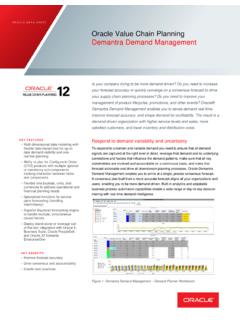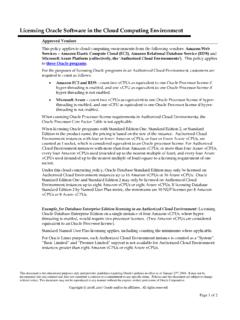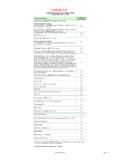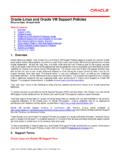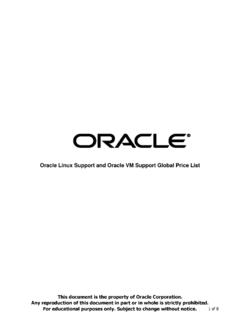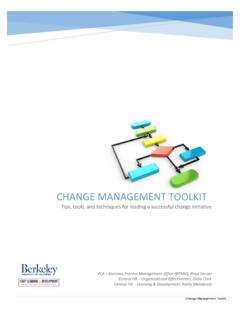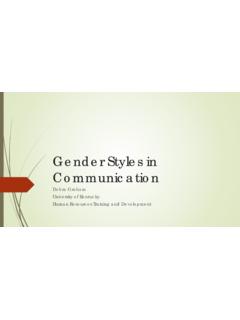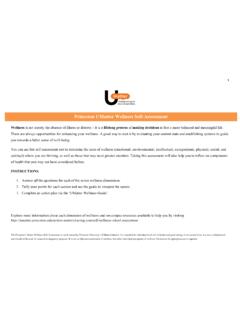Transcription of Digital Twins for IoT Applications - oracle.com
1 Digital Twins FOR IOT Applications Digital Twins for IoT Applications A Comprehensive Approach to Implementing IoT Digital Twins O R A C L E W H I T E P A P E R | J A N U A R Y 2 0 1 7 Disclaimer The following is intended to outline our general product direction. It is intended for information purposes only, and may not be incorporated into any contract. It is not a commitment to deliver any material, code, or functionality, and should not be relied upon in making purchasing decisions. The development, release, and timing of any features or functionality described for oracle s products remains at the sole discretion of oracle .
2 1 | Digital Twins FOR IOT Applications Introduction With the growing deployments of Internet of Things (IoT) systems, the importance of the concept of a Digital avatar of a physical thing has gathered significant interest in the recent years. The most prominent example of this trend can be found in the Gartner s report titled Top 10 Strategic Trends for 2017 published in October 2016, Digital Twins was Number 5 strategic trend for 2017 in this report. These Digital proxies are expected to be built from the domain knowledge of subject matter experts as well as the real time data collected from the devices.
3 It is not a surprise then that most vendors of IoT Platforms have implemented some form of a Digital twin. These are typically named as Twins , shadows, device virtualization, etc. In this whitepaper, we will discuss the origins of the Digital Twins , talk about various implementations in the industry. We will then discuss the Digital twin implementation in oracle IoT Cloud. Origins The term Digital Twin was defined by Dr. Michael Grieves at the University of Michigan around 2001-2002. He originally defined this in the context of Product Lifecycle Management.
4 In his paper, he introduced the concept of a Digital Twin as a virtual representation of what has been manufactured. He promoted the idea of comparing a Digital Twin to its engineering design to better understand what was produced versus what was designed, tightening the loop between design and execution. Dr. Grieves defined the following terms to define the Digital twin: 1. Digital Twin Prototype (DTP): A DTP describes information to create an asset. As an example, a DTP could contain the 3D model of the asset, as well as the Bill of Materials and Bill of Processes describing how to manufacture that asset.
5 Digital Twin Prototype does not refer to a specific instance of the asset. It s rather a recipe for manufacturing an asset. 2. Digital Twin Instance (DTI): A DTI is about a single specific physical instance of an asset. It could contain the list of exact part numbers that went into production of this specific asset, and the exact process steps that were followed in producing the given asset. The Digital Twin Instance also contains the current operational states captured from the sensors connected to the assets. Multiple separate physical assets could be manufactured using a single Digital Twin Prototype, and each of them will have their own Digital Twin Instances.
6 3. Digital Twin Aggregate (DTA): A DTA is simply an aggregation of multiple DTIs, and it allows for querying information about a group of assets. Value of Digital twin The concept of the Digital twin is a very powerful one. Let us briefly look at the typical benefits that this concept provides: 1. Visibility: The Digital twin allows visibility in the operations of the machines as well as in the larger interconnected systems such as a manufacturing plant or an airport 2 | Digital Twins FOR IOT Applications 2. Predictive: Using various modeling techniques (physics-based and mathematics-based), the Digital twin model can be used to predict the future state of the machines 3.
7 What if analysis: Through properly designed interfaces, it is easy to interact with the model and ask the what-if questions to the model to simulate various conditions that are impractical to create in real life 4. Documentation and communication mechanism to understand and explain behaviors: Digital twin model can be used as a communication and documentation mechanism that can be used to understand as well as explain the behaviors of an individual machine or a collection thereof 5. Connect disparate systems such as backend business Applications : If designed correctly, the Digital twin model can be used to connect with the backend business Applications to achieve business outcomes in the context of supply chain operations including manufacturing, procurement, warehousing, transportation and logistics, field service, etc.
8 Industry implementations Looking at the benefits listed above, it should be no surprise that most IoT vendors have taken a keen interest in this concept. Almost every IoT Platform has implemented some sort of Digital twin capabilities though there are really clear differences in terms of their maturity and vision. At a broad level, these implementations typically fall into two categories: 1. Simplistic device models These implementations typically use a JSON document that contains two primary sets of attributes: a. A set of Observed or Reported values: Typically, sensors on the devices read the current values and update these observed attributes.
9 An example of this is the current observed speed of a machine ( 1000 RPM). b. A set of Desired values: These are the values the controlling application desires to be set on the device. For example, an application can set the engine speed to 1200 RPM. In addition to these two primary sets of values, these implementations also store associated information like the name or serial number of the device or its current location in the JSON document. Essentially, these simplistic device models constitute a simple formal asynchronous communication mechanism of the state of the device over the transport protocols like MQTT/HTTP.
10 Note that the asynchronous communication mechanism is needed because the device may be offline, or it may not be efficient to poll the device when the backend wants to communicate with it. In this sense, these models implement only the Operational States captured from actual sensor data - current, past actual part of the DTI concept outlined by Dr. Grieves. 2. Industrial Twins These implementations are typically adopted by the Industrial IoT vendors, and these constitute information from the PLM tools on the design of a machine (similar to the DTP concept outlined by Dr.)
